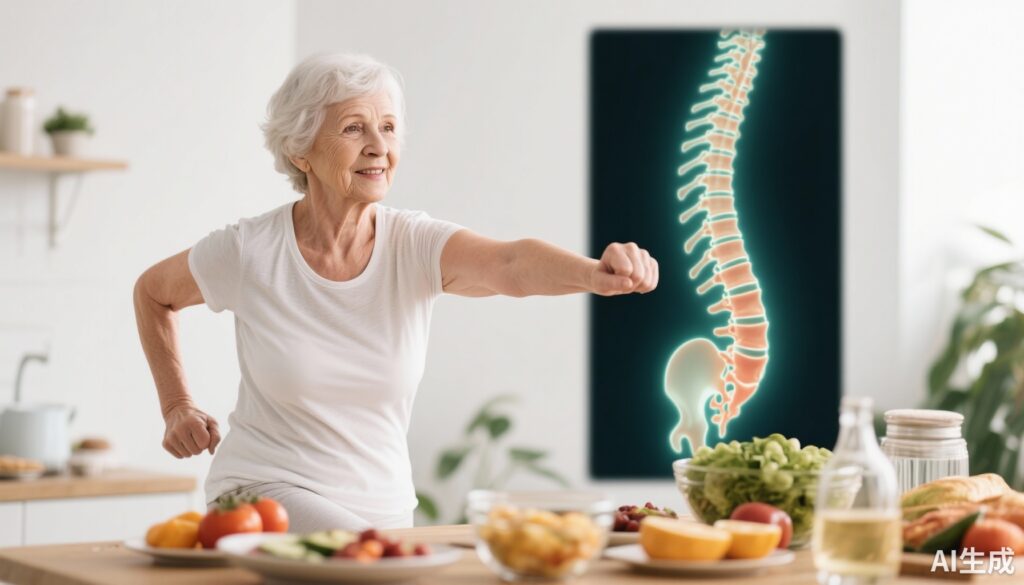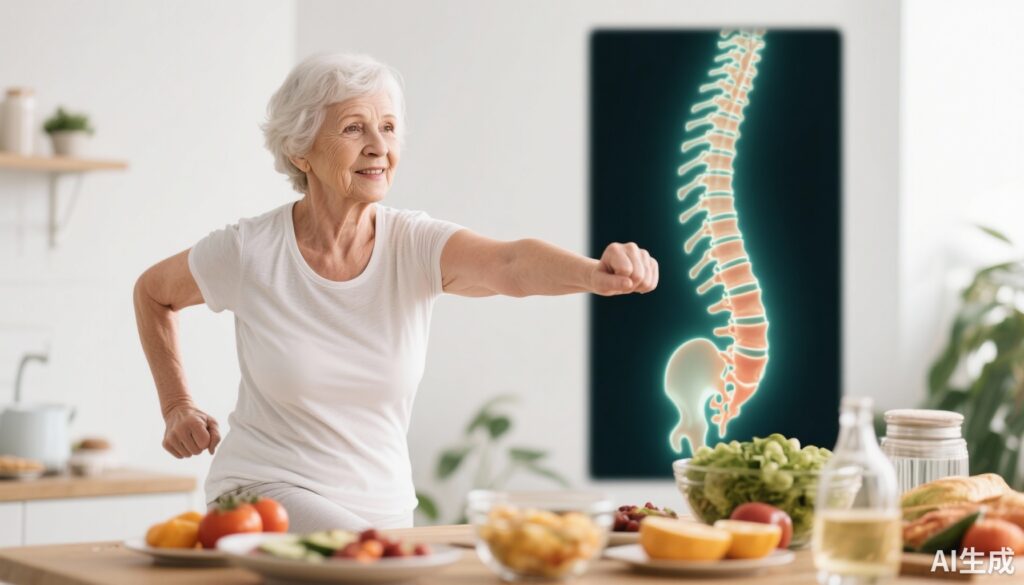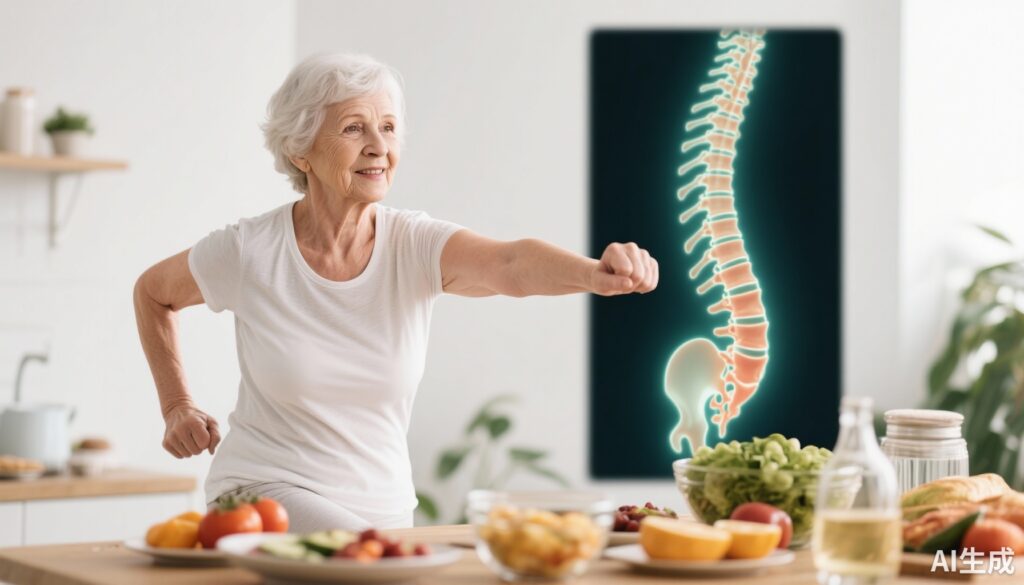Highlight
– A 3-year lifestyle intervention combining an energy-reduced Mediterranean diet and increased physical activity mitigated lumbar spine bone mineral density (BMD) decline in older women with metabolic syndrome.
– The intervention benefits were not observed in men for BMD changes.
– No significant changes were seen in total bone mineral content (BMC) or overall low BMD prevalence after 3 years.
– These findings underscore the potential role of weight-loss and physical activity in preserving bone health during aging.
Study Background and Disease Burden
Osteoporosis and osteopenia are major public health concerns among older adults, characterized by reduced bone mineral density (BMD) and increased fracture risk. Age-related bone deterioration is often exacerbated by concomitant weight loss, especially in individuals with metabolic syndrome, a cluster of conditions associated with obesity, insulin resistance, hypertension, and dyslipidemia. Lifestyle interventions focusing on diet and physical activity present promising strategies to mitigate bone loss. The Mediterranean diet, rich in fruits, vegetables, whole grains, lean proteins, and healthy fats, has been associated with improved bone health and reduced inflammation. However, the impact of combining a weight-loss Mediterranean diet with physical activity specifically on bone mineral parameters in older adults with metabolic syndrome has not been extensively analyzed in randomized controlled trials. This secondary analysis of the PREDIMED-Plus trial addresses this gap by examining bone health outcomes over a 3-year lifestyle intervention.
Study Design
The PREDIMED-Plus trial is a 3-year, parallel-group, randomized clinical trial conducted from October 2013 to December 2016 across multiple centers in Spain, including Navarra, Mallorca, Reus, and León. This prespecified secondary analysis includes 924 men and women aged 55 to 75 years with metabolic syndrome and overweight or obesity who also had dual-energy x-ray absorptiometry (DXA) assessments available.
Participants were randomized 1:1 into two groups:
– Intervention group: Followed an energy-reduced Mediterranean diet designed for weight loss, combined with an increase in physical activity.
– Control group: Advised to adhere to an ad libitum Mediterranean diet without specific physical activity promotion.
Primary outcomes were bone mineral density (BMD) and bone mineral content (BMC), measured using DXA at the total femur, lumbar spine (L1-L4), and femoral trochanter at baseline, 1 year, and 3 years. Osteopenia and osteoporosis status were defined based on T scores derived from BMD variables. Statistical analyses employed linear and logistic two-level mixed models, including intention-to-treat and sensitivity analyses to account for loss to follow-up.
Key Findings
Participants (mean age 65.1 years, 49.1% women) were analyzed over the 3-year intervention period. Major results include:
– Lumbar Spine BMD: The intervention group showed significant protection against BMD decline at the lumbar spine (L1-L4) site compared to controls, with between-group differences of -0.1 g/cm2 at 1 year (95% CI, -0.8 to 0.8) and 0.9 g/cm2 at 3 years (95% CI, 0.1-1.8; P = .05 overall).
– Sex-Specific Outcomes: This protective effect was primarily observed among women, who had an increase in lumbar spine BMD of 1.8 g/cm2 at 3 years (95% CI, 0.6-2.9; P = .005 overall). Men in the intervention group did not demonstrate significant BMD changes.
– Total BMC and Low BMD Prevalence: No statistically significant differences were observed between intervention and control groups in total bone mineral content or prevalence of low BMD (osteopenia or osteoporosis) after 3 years.
– Safety: No adverse events related to bone outcomes were reported.
These findings suggest that the combined effect of calorie restriction through a Mediterranean diet and physical activity helps to counteract age- and weight loss-related BMD decline in older women with metabolic syndrome.
Expert Commentary
The PREDIMED-Plus trial’s secondary analysis provides compelling evidence supporting the role of a weight-loss Mediterranean diet coupled with physical activity in preserving lumbar spine bone mineral density in older women. This is particularly relevant as postmenopausal women are at increased risk of osteoporosis due to hormonal changes accelerating bone loss.
The absence of significant BMD benefits in men could be attributed to sex-based differences in bone metabolism, hormonal milieu, or adherence patterns that warrant further investigation. Additionally, the lack of effect on total BMC and low BMD prevalence may reflect the complex interplay of bone remodeling dynamics or insufficient statistical power to detect changes in these parameters over the study duration.
Limitations include the secondary analysis design, potential variability in physical activity adherence, and limited geographic diversity, which may constrain generalizability to other populations. Longer-term follow-up is necessary to determine if these BMD benefits translate into reduced fracture risk.
Mechanistically, the Mediterranean diet provides abundant antioxidants, anti-inflammatory nutrients, and adequate calcium and vitamin D, which in combination with weight-bearing physical activity, can enhance osteoblast function and suppress bone resorption.
These data align with current clinical guidelines advocating lifestyle modifications, including diet and exercise, as cornerstone interventions in managing osteoporosis risk, particularly among older adults with metabolic syndrome.
Conclusion
This prespecified secondary analysis of the PREDIMED-Plus randomized clinical trial demonstrates that a lifestyle intervention incorporating an energy-reduced Mediterranean diet and increased physical activity mitigates lumbar spine BMD decline in older women with metabolic syndrome over three years. While benefits were sex-specific and limited to lumbar spine BMD, these findings reinforce the importance of integrated dietary and physical activity strategies in bone health preservation during aging and weight loss.
Future studies with extended follow-up and fracture endpoints are critically needed to validate these findings and guide clinical recommendations. Meanwhile, clinicians should consider individualized lifestyle interventions to address bone health in overweight and metabolically compromised older adults.
References
1. Vázquez-Lorente H, García-Gavilán JF, Shyam S, et al. Mediterranean Diet, Physical Activity, and Bone Health in Older Adults: A Secondary Analysis of a Randomized Clinical Trial. JAMA Netw Open. 2025;8(4):e253710. doi:10.1001/jamanetworkopen.2025.3710
2. Kanis JA, McCloskey EV, Johansson H, et al. European guidance for the diagnosis and management of osteoporosis in postmenopausal women. Osteoporos Int. 2013;24(1):23-57. doi:10.1007/s00198-012-2074-y
3. Shapses SA, Sukumar D. Bone metabolism in obesity and weight loss. Annu Rev Nutr. 2012;32:287-309. doi:10.1146/annurev.nutr.012809.104655
4. Rizzoli R, Reginster JY, Arnal JF, et al. Calcium supplementation: why, which, and how? Bone. 2013;57(2):542-548. doi:10.1016/j.bone.2013.06.032
5. Chen Z, Chen J, He Y, et al. Effect of Mediterranean diet on bone mineral density and fracture risk: a systematic review and meta-analysis. Nutrients. 2022;14(15):3074. https://doi.org/10.3390/nu14153074



